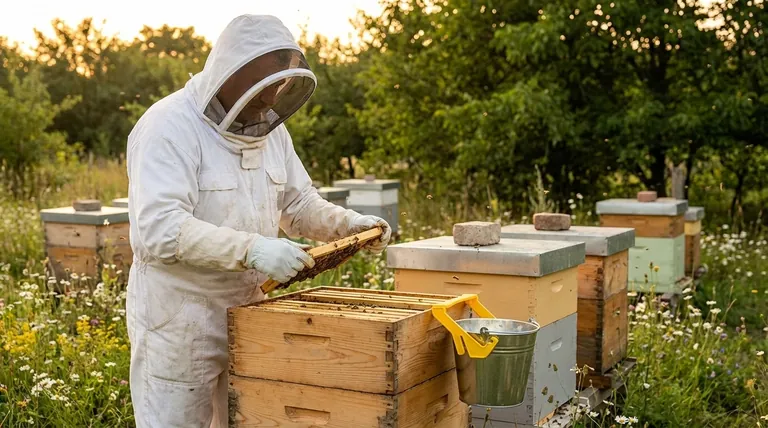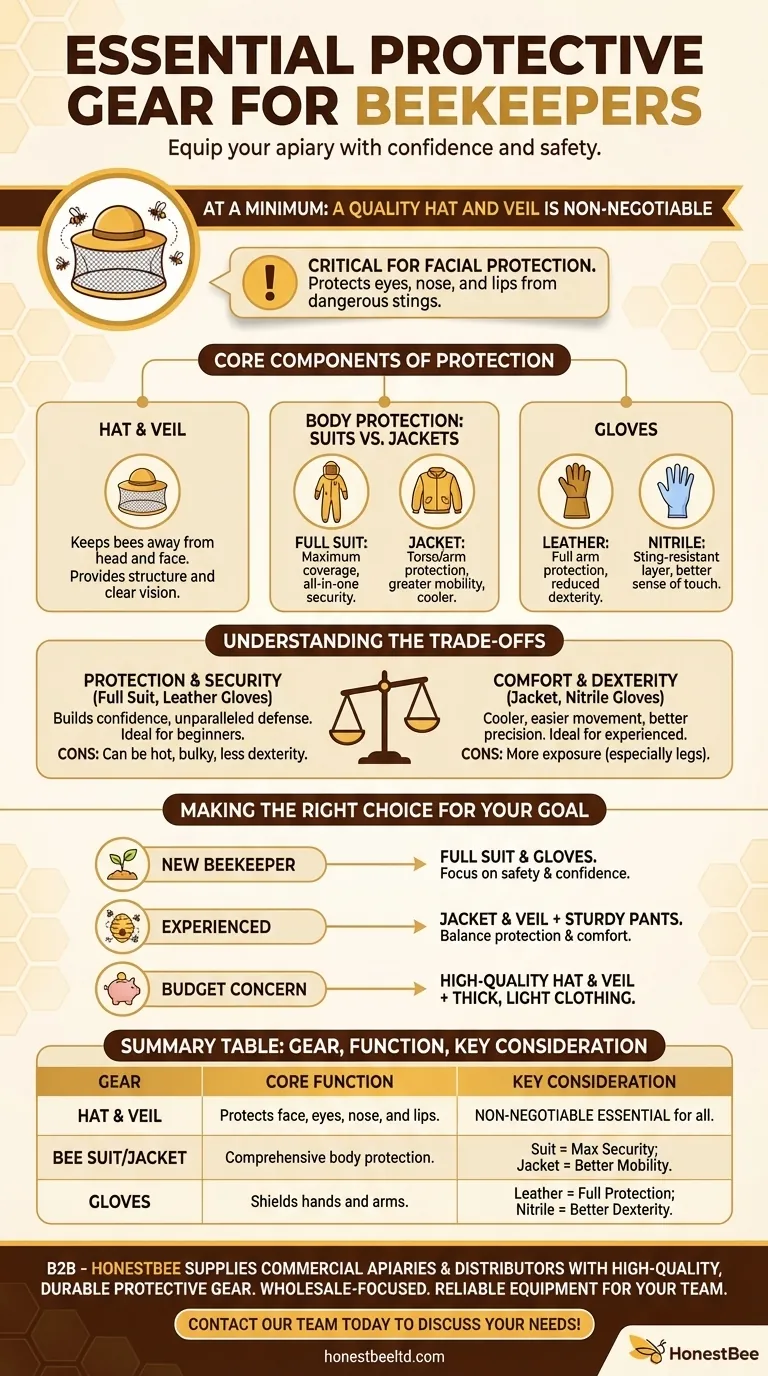At a minimum, the one piece of protective gear every beekeeper must have is a quality hat and veil. This protects your face, eyes, nose, and lips from stings, which are the most dangerous and distressing. While a veil is the non-negotiable essential, a full bee suit or jacket and gloves are highly recommended to provide comprehensive protection and build confidence when handling your hives.
The choice of beekeeping gear is not about finding a single "best" setup, but about making an informed trade-off between maximum protection, comfort, and dexterity based on your experience level and the temperament of your bees.

Why Protective Gear is Non-Negotiable
Working with bees involves the inherent risk of getting stung. Protective clothing creates a necessary barrier between you and the bees, allowing you to work calmly and confidently.
The Critical Need for Facial Protection
Stings are painful anywhere, but stings to the face are especially dangerous and can cause significant swelling around the eyes, nose, and mouth. A veil is your most critical piece of equipment because it reliably protects these sensitive areas.
Even the most experienced beekeepers with the gentlest hives always wear a veil. It is the one item you should never compromise on.
The Core Components of Beekeeper Protection
Your protective setup can range from a simple veil to a full-body suit. Understanding the function of each component will help you choose the right level of coverage.
The Veil and Hat: Your First Line of Defense
The hat and veil combination is designed to keep bees away from your head and face. The hat provides structure, keeping the mesh of the veil from touching your skin, while the veil provides a clear, protected field of vision.
Body Protection: Suits vs. Jackets
A full bee suit offers the most comprehensive coverage, combining pants, a torso section, and a veil into a single garment. It provides maximum security against stings anywhere on your body.
A beekeeping jacket is a popular alternative that offers protection for your torso and arms and typically includes an integrated veil. Beekeepers often pair a jacket with durable, light-colored pants like jeans for a setup that is easier to put on and offers more mobility.
Hand Protection: Gloves
Beekeeping gloves protect your hands, which are in constant proximity to the bees. Traditional gloves are made of leather and extend up the arm for added protection, though they can reduce dexterity.
Many beekeepers also use disposable nitrile gloves over their bare hands or thinner leather gloves. This provides a sting-resistant layer while preserving a much better sense of touch for delicate hive manipulations.
Understanding the Trade-offs
Choosing gear is a balancing act. What you gain in protection, you might sacrifice in comfort or maneuverability.
Protection vs. Dexterity
Thicker materials and full suits offer unparalleled protection, which is crucial for building confidence as a beginner. However, bulky gloves and heavy suits can make it harder to handle frames and tools with precision.
Security vs. Comfort
A full bee suit provides peace of mind, knowing you are completely sealed off from stings. The downside is that they can be very hot and cumbersome, especially during warm weather. A jacket offers a cooler, less restrictive alternative but leaves your legs more exposed.
Experience and Hive Temperament
As you gain experience, you will learn to read the bees' mood and move with deliberate calm. Experienced beekeepers with gentle hives may opt for less gear, such as just a veil and jacket. Beginners are almost always better served by erring on the side of more protection.
Making the Right Choice for Your Goal
Your ideal protective gear depends on your comfort level and how long you have been keeping bees.
- If you are a new beekeeper: Your primary focus should be safety and confidence. Opt for a full suit with gloves to ensure maximum protection while you learn.
- If you are an experienced beekeeper: You can balance protection with comfort. A jacket-and-veil combination paired with sturdy pants may be sufficient for routine inspections.
- If your budget is a primary concern: At the absolute minimum, invest in a high-quality hat and veil. You can pair this with thick, light-colored clothing you already own.
Ultimately, the right gear is the gear that allows you to work safely and effectively without fear.
Summary Table:
| Protective Gear | Core Function | Key Consideration |
|---|---|---|
| Hat & Veil | Protects face, eyes, nose, and lips from stings. | Non-negotiable essential for all beekeepers. |
| Bee Suit/Jacket | Provides comprehensive body protection. | Full suit offers maximum security; jacket offers better mobility. |
| Gloves | Shields hands and arms from stings. | Leather for full protection; nitrile for better dexterity. |
Equip your apiary with confidence and safety. At HONESTBEE, we supply commercial apiaries and beekeeping equipment distributors with high-quality, durable protective gear designed for professional use. Our wholesale-focused operations ensure you get the reliable equipment you need to protect your team and manage your hives effectively. Contact our team today to discuss your needs and get a quote!
Visual Guide

Related Products
- Yellow Plastic Bucket Pail Perch for Beekeeping
- Long Langstroth Style Horizontal Top Bar Hive for Wholesale
- Professional 3-Bar Frame Grip with Integrated Hive Tool
- Metal Bee Hive Stand Bee Box Stand for Beekeeping
- Professional Dual-End Stainless Steel Hive Tool for Beekeeping
People Also Ask
- How do beekeeping gloves protect against stings? Essential Gear for Apiary Safety
- What is the best place to keep bees? Find the Perfect Apiary Site for Your Hives
- What are the essential pieces of equipment for most beekeepers? Get Started with the Right Gear
- What should beginners consider when purchasing beekeeping equipment? A Guide to Essential Starter Gear
- What does every bee keeper need? Your Essential Guide to Starting Strong



















